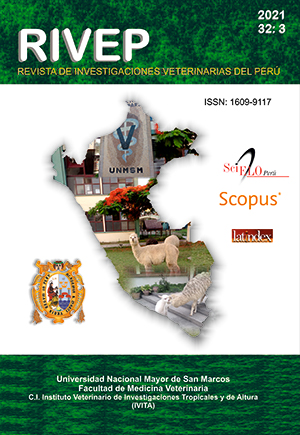Chemical characterization and in vitro digestibility of Amazonian seeds and agro-industrial by-products with potential for animal feed
DOI:
https://doi.org/10.15381/rivep.v32i3.18765Keywords:
biochemistry, nutritional composition, agro-industrial waste, oilseeds, subproductsAbstract
The chemical characteristics and in vitro digestibility of eleven inputs, divided into three groups were determined: seeds (sacha inchi [(Plukenetia volubilis], castor [Ricinus communis] and chia [Salvia hispanica]), by-products derived from rice (nielen, husk and powder) and agro-industrial residues of tropical plants and fruits (sugarcane bagasse, coffee pulp, outer shell and mucilage of cocoa [Theobroma cacao], orange pulp [Citrus sinensis] and bean pod [Caesalpinia spinosa]) with potential in animal feed. The samples were collected in the Amazon region, Peru. Its proximal composition, crude fibre content (FC), neutral detergent fibre (NDF), acid detergent fibre (ADF), calcium and phosphorus, as well as in vitro digestibility and gross energy (EB) were determined. Oilseeds stood out for their high oil content, high energy value and an important source of calcium and phosphorus; sacha inchi presented high protein content of 28.75 ± 0.29%. Rice by-products were shown to be important sources of carbohydrates, with high digestibility except for the husk. The latter, like the residues of sugar cane and cocoa, showed a high content of FC, FDA and NDF. Among the other agro-industrial residues, the coffee pulp presented higher protein content with 9.7%; orange and bean residues have higher calcium values (between 0.5 and 0.7%), phosphorus (between 0.3 and 0.5%) and high digestibility (between 93 and 95%). Therefore, the evaluated inputs, due to their chemical composition, low cost and bioavailability, show potential for animal feed.
Downloads
Downloads
Published
Issue
Section
License
Copyright (c) 2021 Ives Julian Yoplac, Katerin Goñas, Wilmer Bernal, Héctor V. Vásquez, Jorge L. Maicelo

This work is licensed under a Creative Commons Attribution 4.0 International License.
AUTHORS RETAIN THEIR RIGHTS:
a. Authors retain their trade mark rights and patent, and also on any process or procedure described in the article.
b. Authors retain their right to share, copy, distribute, perform and publicly communicate their article (eg, to place their article in an institutional repository or publish it in a book), with an acknowledgment of its initial publication in the Revista de Investigaciones Veterinarias del Perú (RIVEP).
c. Authors retain theirs right to make a subsequent publication of their work, to use the article or any part thereof (eg a compilation of his papers, lecture notes, thesis, or a book), always indicating the source of publication (the originator of the work, journal, volume, number and date).










